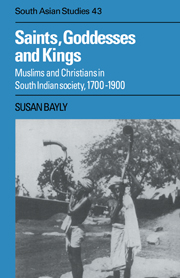Book contents
- Frontmatter
- Contents
- List of plates
- List of maps
- Preface
- Note on transliteration
- List of abbreviations
- Introduction
- Part I
- Part II
- 7 South Indian Christians in the pre-colonial period
- 8 The collapse of Syrian Christian ‘integration’
- 9 The Christian Paravas of southern Tamilnad
- 10 Christian saints and gurus in the poligar country
- 11 Christianity and colonial rule in the Tamil hinterland
- 12 Conclusion
- Select glossary
- Bibliography
- Index
- CAMBRIDGE SOUTH ASIAN STUDIES
- Plate section
8 - The collapse of Syrian Christian ‘integration’
from Part II
Published online by Cambridge University Press: 04 December 2009
- Frontmatter
- Contents
- List of plates
- List of maps
- Preface
- Note on transliteration
- List of abbreviations
- Introduction
- Part I
- Part II
- 7 South Indian Christians in the pre-colonial period
- 8 The collapse of Syrian Christian ‘integration’
- 9 The Christian Paravas of southern Tamilnad
- 10 Christian saints and gurus in the poligar country
- 11 Christianity and colonial rule in the Tamil hinterland
- 12 Conclusion
- Select glossary
- Bibliography
- Index
- CAMBRIDGE SOUTH ASIAN STUDIES
- Plate section
Summary
During the nineteenth century the St Thomas Christians lost their role as privileged warriors and office-holders within the Hindu states of Malabar. Their problems of internal leadership worsened, and to make matters worse, the Syrians were badly hit by a disruption in the bonds of shared ceremonial which had linked them to the region's Hindu service and military groups. These changes began with the collapse of the political order which had been created by the region's eighteenth-century rajas. First came the humiliation of the Mysorean invasion in which the forces of Tipu Sultan reduced Cochin to a tributary client state and overran the keystone of Martanda Varma's defence system, the chain of fortifications known as the Aramboli lines. In 1795 the rajas of Travancore and Cochin entered into tributary alliances with the English East Indian Company. As in so many other Indian kingdoms, this meant that the Company agreed to underwrite the states' military security but at such a high price that they were soon reduced to the status of impecunious client regimes.
The first British Resident was appointed to the two courts in 1800, and this was followed by a rapid disintegration in the states' military organisation and in the system of ceremonial office and ritual which had secured it. Both rulers were forced to cut military expenditure so as to meet their ever-growing arrears of tribute, and these measures provoked armed risings of the Travancore and Cochin armies in 1804 and again in 1808. After putting down the second of these outbreaks the British forced the two states to disband their armies.
- Type
- Chapter
- Information
- Saints, Goddesses and KingsMuslims and Christians in South Indian Society, 1700–1900, pp. 281 - 320Publisher: Cambridge University PressPrint publication year: 1990



